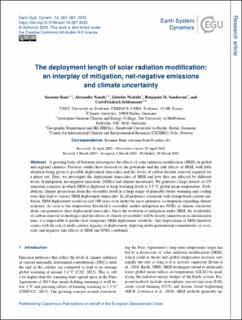| dc.contributor.author | Baur, Susanne | |
| dc.contributor.author | Nauels, Alexander | |
| dc.contributor.author | Nicholls, Zebedee | |
| dc.contributor.author | Sanderson, Benjamin M. | |
| dc.contributor.author | Schleussner, Carl-Friedrich | |
| dc.date.accessioned | 2024-02-22T10:11:04Z | |
| dc.date.available | 2024-02-22T10:11:04Z | |
| dc.date.created | 2023-04-20T18:50:42Z | |
| dc.date.issued | 2023 | |
| dc.identifier.citation | Earth System Dynamics (ESD). 2023, 14 (2), 367-381. | en_US |
| dc.identifier.issn | 2190-4979 | |
| dc.identifier.uri | https://hdl.handle.net/11250/3119253 | |
| dc.description.abstract | A growing body of literature investigates the effects of solar radiation modification (SRM) on global and regional climates. Previous studies have focused on the potentials and the side effects of SRM, with little attention being given to possible deployment timescales and the levels of carbon dioxide removal required for a phase out. Here, we investigate the deployment timescales of SRM and how they are affected by different levels of mitigation, net-negative emissions (NNEs) and climate uncertainty. We generate a large dataset of 355 emission scenarios in which SRM is deployed to keep warming levels at 1.5 C global mean temperature. Probabilistic climate projections from this ensemble result in a large range of plausible future warming and cooling rates that lead to various SRM deployment timescales. In all pathways consistent with extrapolated current ambition, SRM deployment would exceed 100 years even under the most optimistic assumptions regarding climate response. As soon as the temperature threshold is exceeded, neither mitigation nor NNEs or climate sensitivity alone can guarantee short deployment timescales. Since the evolution of mitigation under SRM, the availability of carbon removal technologies and the effects of climate reversibility will be mostly unknown at its initialisation time, it is impossible to predict how temporary SRM deployment would be. Any deployment of SRM therefore comes with the risk of multi-century legacies of deployment, implying multi-generational commitments of costs, risks and negative side effects of SRM and NNEs combined. | en_US |
| dc.language.iso | eng | en_US |
| dc.publisher | EGU | en_US |
| dc.rights | Navngivelse 4.0 Internasjonal | * |
| dc.rights.uri | http://creativecommons.org/licenses/by/4.0/deed.no | * |
| dc.title | The deployment length of solar radiation modification: an interplay of mitigation, net-negative emissions and climate uncertainty | en_US |
| dc.title.alternative | The deployment length of solar radiation modification: an interplay of mitigation, net-negative emissions and climate uncertainty | en_US |
| dc.type | Peer reviewed | en_US |
| dc.type | Journal article | en_US |
| dc.description.version | publishedVersion | en_US |
| dc.source.pagenumber | 367-381 | en_US |
| dc.source.volume | 14 | en_US |
| dc.source.journal | Earth System Dynamics (ESD) | en_US |
| dc.source.issue | 2 | en_US |
| dc.identifier.doi | 10.5194/esd-14-367-2023 | |
| dc.identifier.cristin | 2142297 | |
| dc.relation.project | EC/H2020/101003687 | en_US |
| dc.relation.project | EC/H2020/820829 | en_US |
| dc.relation.project | EC/H2020/101003536 | en_US |
| cristin.ispublished | true | |
| cristin.fulltext | original | |
| cristin.qualitycode | 1 | |

